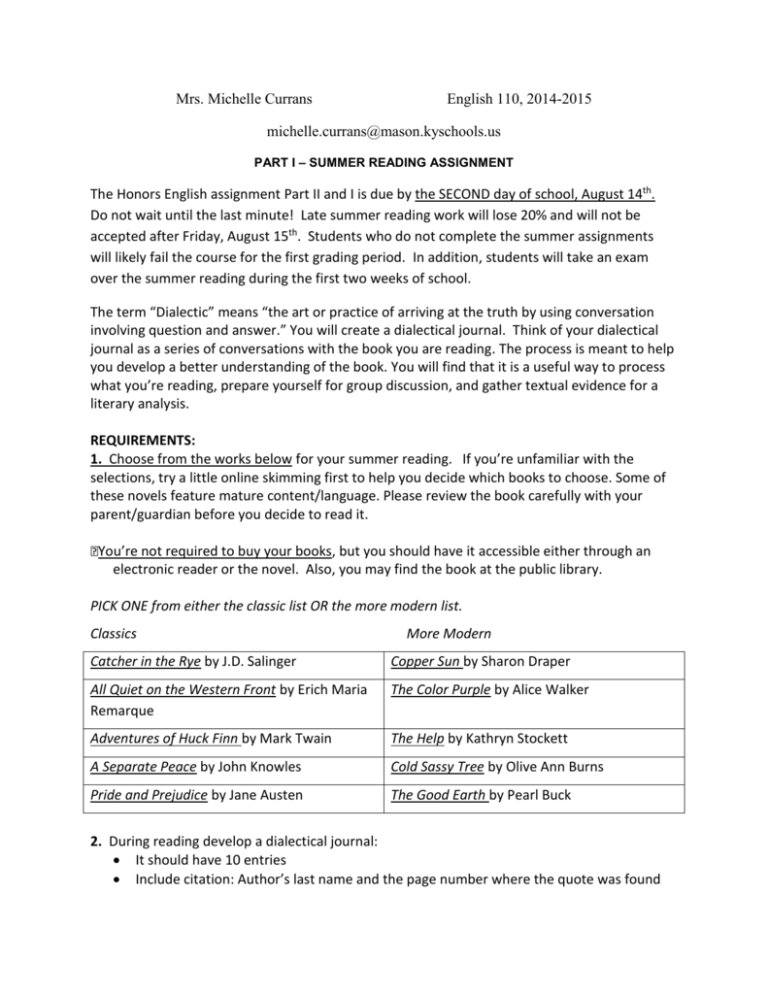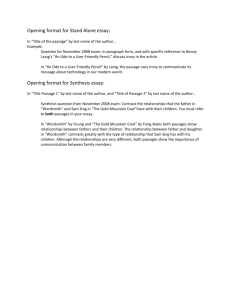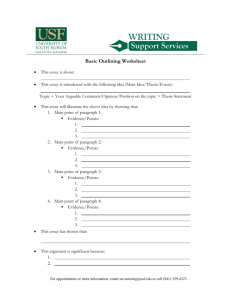Summer Assignment 2014-2015
advertisement

Mrs. Michelle Currans English 110, 2014-2015 michelle.currans@mason.kyschools.us PART I – SUMMER READING ASSIGNMENT The Honors English assignment Part II and I is due by the SECOND day of school, August 14th. Do not wait until the last minute! Late summer reading work will lose 20% and will not be accepted after Friday, August 15th. Students who do not complete the summer assignments will likely fail the course for the first grading period. In addition, students will take an exam over the summer reading during the first two weeks of school. The term “Dialectic” means “the art or practice of arriving at the truth by using conversation involving question and answer.” You will create a dialectical journal. Think of your dialectical journal as a series of conversations with the book you are reading. The process is meant to help you develop a better understanding of the book. You will find that it is a useful way to process what you’re reading, prepare yourself for group discussion, and gather textual evidence for a literary analysis. REQUIREMENTS: 1. Choose from the works below for your summer reading. If you’re unfamiliar with the selections, try a little online skimming first to help you decide which books to choose. Some of these novels feature mature content/language. Please review the book carefully with your parent/guardian before you decide to read it. You’re not required to buy your books, but you should have it accessible either through an electronic reader or the novel. Also, you may find the book at the public library. PICK ONE from either the classic list OR the more modern list. Classics More Modern Catcher in the Rye by J.D. Salinger Copper Sun by Sharon Draper All Quiet on the Western Front by Erich Maria Remarque The Color Purple by Alice Walker Adventures of Huck Finn by Mark Twain The Help by Kathryn Stockett A Separate Peace by John Knowles Cold Sassy Tree by Olive Ann Burns Pride and Prejudice by Jane Austen The Good Earth by Pearl Buck 2. During reading develop a dialectical journal: It should have 10 entries Include citation: Author’s last name and the page number where the quote was found Date each journal with the date you wrote the entry Preferably typed: standard, 12-point font, and Times New Roman only As you read, choose passages that stand out to you and record them in the left-hand column of the chart (include citation). In the right column, write your response to the text (ideas/insights, questions, reflections, and comments on each passage) You MUST label your responses using the following codes: o (Q) Question- ask about something in the passage that is unclear o (C) Connect- make a connection to your life, the world, or another text o (P) Predict- anticipate what will occur based on what’s in the passage o (CL) Clarify- answer earlier questions or confirm/disaffirm a prediction o (R) Reflect- think deeply about what the passage means in a broad sense- not just to the characters in the story/author. What conclusions can you draw about the world, about human nature, or just the way things work? o (E) Evaluate- make a judgment about what the author is trying to say o (V) Vocabulary- Define an unfamiliar word Each entry must have AT LEAST 2 different coded responses. In your 10 entries you should use all the coded responses at least twice. Use a variety. For example, don’t use Q and C for each entry. YOUR ENTRIES MUST SHOW PROGRESS IN READING YOUR BOOK. You should not do multiple entries from the same chapters or all from the beginning of the book. CHOOSING PASSAGES FROM THE TEXT: Look for quotes that seem significant, powerful, thought provoking or puzzling. For example, you might record: o Effective and/or creative use of stylistic or literary devices o Passages that remind you of your own life or something you’ve seen before o Structural shifts or turns in the plot o A passage that makes you realize something you hadn’t seen before o Examples of patterns: recurring images, ideas, colors, symbols, or motifs o Passages with confusing language or unfamiliar vocabulary o Events you find surprising or confusing o Passages that illustrate a particular character or setting RESPONDING TO THE TEXT: You can respond to the text in a variety of ways. The most important thing to remember is that your observations should be specific and detailed. Basic Responses: o Raise questions about the beliefs and values implied in the text o Give your personal reactions to the passage o Discuss words, ideas, or action of the author or character(s) o Tell what it reminds you of from your own experiences o Write about what it makes you think or feel o Agree or disagree with a character or the author Sample Sentence Starters: I really don’t understand this because… I really dislike/like this idea because… I think the author is trying to say that… This passage reminds me of a time in my life when… If I were (name character) at this point I would… This part doesn’t make sense because… This character reminds me of (name of person) because… Higher Level Responses o Analyze the text for use of literary devices (tone, figurative language, diction, style, structure, point of view, etc.) o Make connections between different characters or events in the text o Make connections to a different text (or film, song, etc…) o Discuss the words, ideas, or actions of the author or character(s) o Consider an event or description from the perspective of a different character o Analyze a passage and its relationship to the story as a whole SAMPLE ENTRY QUOTATION RESPONSE TO THE QUOTATION SELECTED August 25, 2013 “But my mother’s hair, my mother’s hair, like little rosettes, like little candy circles all curly and pretty because she pinned it in pin curls all day, sweet to put your nose into when she is holding you, holding you and you feel safe, is the warm smell of bread before you bake it, is the smell when she makes room for you on her side of the bed” (Cisneros, PAGE 6). (E) Something I concluded here is that the long list of similes and metaphors describing her mother’s hair must be important. She describes her father’s hair in one sentence-as well as the hair of the other family members. The repetition of “holding you” is a clue as well. She obviously has a strong connection to her mother and it must be the most important relationship in her life-at least in her family. Other evidence of this closeness is the association of a smell-the smell of bread with her mother. (C) I relate smells with certain memories. The smell of sunscreen reminds me of when the kids were little and we took them to the ocean for the first time. Every time I smell it I am transported back to that carefree time with my husband and boys. Warm bread symbolizes comfort and care. It takes time and patience to bake bread—just like being a mom. (Q) Does all of this talk about her mother’s hair foreshadows or symbolizes something greater in the text? (P) I think something is going to happen to her mother’s hair. PART II - ESSAY Write a five-paragraph personal essay describing your life, your dreams or worries about ninth grade or high school, and your goals for ninth grade and the future. The introduction paragraph should include a thesis statement. In the first body paragraph of the essay, make assertions about yourself and provide personal details about your life. You may talk about family, pets, interests, hobbies, favorite books, etc. In the second body paragraph of the essay, address your dreams or worries about ninth grade or high school. What are some things you wish for, aspects of your life you hope to improve, concerns or fears about ninth grade or high school, or what you imagine it will be like. In the third body paragraph of the essay, describe your goals. What are your academic goals, personal goals, physical, spiritual, or social goals for high school and after? Last paragraph should be a conclusion paragraph. Good planning and organization is the key to writing an effective essay. Be sure to use prewriting strategies to plan your first draft. As you revise and edit your first draft, reconsider your content and message; try to write smooth transitions, correct spelling and usage, and use sharp, specific verbs and nouns. Have fun with this essay and let me know all about YOU!







